
Cockfighting is a blood sport involving roosters ("cocks"), held in a ring called a cockpit. The first documented use of the word gamecock, denoting use of the cock as to a "game", a sport, pastime or entertainment, was recorded in 1634, after the term "cock of the game" used by George Wilson, in the earliest known book on the sport of cockfighting in The Commendation of Cocks and Cock Fighting in 1607. But it was during Magellan's voyage of discovery of the Philippines in 1521 when modern cockfighting was first witnessed and documented for Westerners by the Italian Antonio Pigafetta, Magellan's chronicler, in the Kingdom of Taytay.

Bull-baiting is a blood sport involving pitting a bull against dogs with the aim of attacking and subduing the bull by biting and holding onto its nose or neck, which often resulted in the death of the bull.
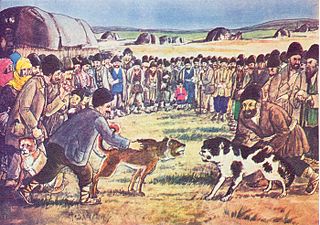
Dog fighting is a type of blood sport that turns game and fighting dogs against each other in a physical fight, often to the death, for the purposes of gambling or entertainment to the spectators. In rural areas, fights are often staged in barns or outdoor pits; in urban areas, fights are often staged in garages, basements, warehouses, alleyways, abandoned buildings, neighborhood playgrounds, or in the streets. Dog fights usually last until one dog is declared a winner, which occurs when one dog fails to scratch, dies, or jumps out of the pit. Sometimes dog fights end without declaring a winner; for instance, the dog's owner may call the fight.
The Royal Society for the Prevention of Cruelty to Animals (RSPCA) is a charity operating in England and Wales which promotes animal welfare.

Cruelty to animals, also called animal abuse, animal neglect or animal cruelty, is the infliction of suffering or harm by humans upon non-human animals, either by omission (neglect) or by commission. More narrowly, it can be the causing of harm or suffering for specific achievements, such as killing animals for entertainment; cruelty to animals sometimes encompasses inflicting harm or suffering as an end in itself, referred to as zoosadism. Divergent approaches to laws concerning animal cruelty occur in different jurisdictions throughout the world. For example, some laws govern methods of killing animals for food, clothing, or other products, and other laws concern the keeping of animals for entertainment, education, research, or pets. There are several conceptual approaches to the issue of cruelty to animals.

Joseph Pease was a British proponent and supporter of the Stockton and Darlington Railway Company, one of first public railway systems in the world, and was the first Quaker permitted to take his seat in Parliament.

The Royal New Zealand Society for the Prevention of Cruelty to Animals is a New Zealand charitable society who work to promote the humane treatment of animals. The society consists of 30 animal shelters and 6 vet partnerships around New Zealand, including many in regional areas. Under the Animal Welfare Act 1999, SPCA inspectors have the exclusive power to investigate animal welfare complaints and prosecute abusers when necessary. The Royal NZ SPCA has initiated a range of animal welfare campaigns. It has launched public education campaigns about the humane treatment of animals, and has encouraged people to change their behaviour towards animals. SPCA has also run advocacy campaigns aimed at promoting law changes or questioning the legality of certain practices.

A blood sport or bloodsport is a category of sport or entertainment that involves bloodshed. Common examples of the former include combat sports such as cockfighting and dog fighting, and some forms of hunting and fishing. Activities characterized as blood sports, but involving only human participants, include the ancient Roman gladiatorial games.
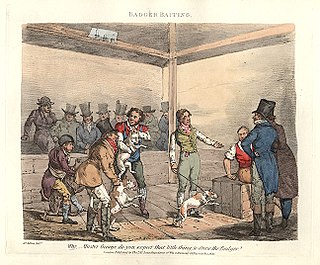
Badger-baiting is a form of blood sport in which badgers are baited with dogs. A baiting session typically results in the death of the badger, and possibly serious injuries to the dogs.

The Cruel Treatment of Cattle Act 1822 was an Act of the Parliament of the United Kingdom with the long title "An Act to prevent the cruel and improper Treatment of Cattle"; it is sometimes known as Martin's Act, after the MP and animal rights campaigner Richard Martin. It is the first known piece of animal welfare legislation in the world.

Animals in sport are a specific form of working animals. Many animals, at least in more commercial sports, are highly trained. Two of the most common animals in sport are horses and dogs.

The Cruelty to Animals Act 1849 is an act of the Parliament of the United Kingdom with the long title An Act for the more effectual Prevention of Cruelty to Animals.

Dog fighting in the United States is an activity in which fights between two game dogs are staged as a form of entertainment and gambling. Such activity has existed since the early 19th century in the United States and was gradually prohibited in all states. It continues as an underground activity in both rural and urban locations.
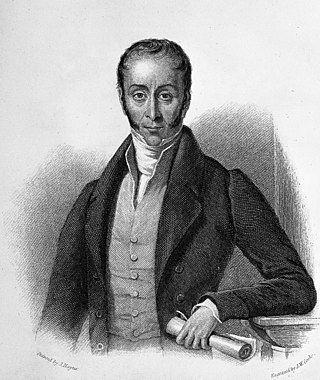
William Alexander Mackinnon DL JP FRS was a British politician and a colonisation commissioner for South Australia.
The concept of moral rights for animals is believed to date as far back as Ancient India, particularly early Jainist and Hindu history. What follows is mainly the history of animal rights in the Western world. There is a rich history of animal protection in the ancient texts, lives, and stories of Eastern, African, and Indigenous peoples.
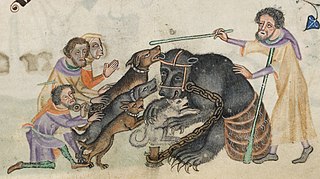
Bear-baiting is a blood sport in which a chained bear and one or more dogs are forced to fight one another. It may also involve pitting a bear against another animal. Until the 19th century, it was commonly performed in Great Britain, Sweden, India, Pakistan, and Mexico among others.
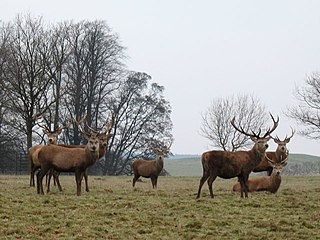
Animal welfare in the United Kingdom relates to the treatment of animals in fields such as agriculture, hunting, medical testing and the domestic ownership of animals. It is distinct from animal conservation.
Animal welfare and rights in India regards the treatment of and laws concerning non-human animals in India. It is distinct from animal conservation in India.
Animal welfare and rights in Malaysia is about the laws concerning and treatment of non-human animals in Malaysia. Malaysia has had a national animal welfare law since 1953, though it was criticized for being weak and under-enforced. In 2015, Malaysia passed an updated animal welfare law strengthening protections for animals and penalties for animal cruelty. Animal protection efforts in Malaysia appear to be exclusively welfare-driven rather than rights-driven.
Animal welfare and rights in Mexico regards the treatment of and laws concerning non-human animals in Mexico.
















